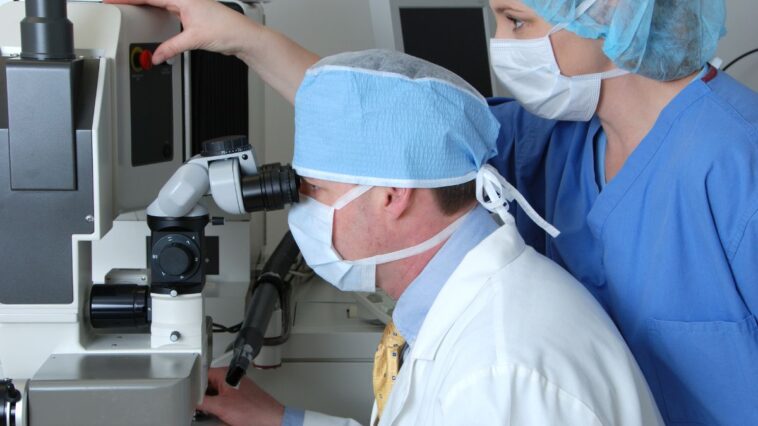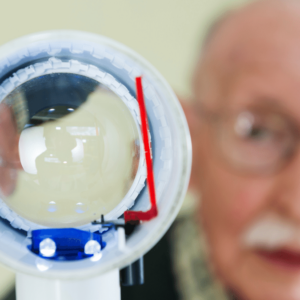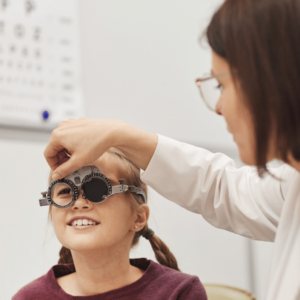What Is LASIK Surgery?
LASIK surgery is a refractive surgical procedure used to correct vision disorders such as nearsightedness, farsightedness, and astigmatism. This procedure entails using a laser to alter the shape of the cornea, which is the clear front portion of the eye that bends light as it enters the eye.
During LASIK surgery, the surgeon creates a thin, hinged flap in the cornea using a particular instrument called a microkeratome or a femtosecond laser. The flap is lifted, and a computer-controlled laser removes a precise amount of corneal tissue, reshaping the cornea to improve its ability to focus light onto the retina.
After the cornea has been reshaped, the flap is repositioned and left to heal on its own without the need for stitches. LASIK surgery typically takes less than 30 minutes, and most people can resume normal activities within a day or two after the surgery.
LASIK surgery is a popular option for people who want to reduce or eliminate their dependence on glasses or contact lenses. However, only some are good candidates for LASIK surgery, and it’s important to discuss your options with an eye doctor to determine whether LASIK surgery is right for you.
How Long Is The LASIK Recovery Time?
LASIK recovery time varies from person to person, but most people can expect to experience some degree of blurry vision and discomfort immediately after the surgery. However, the actual recovery time will depend on the individual’s age, overall health, and the severity of their refractive error.
Most people can resume normal activities within a day or two after the surgery. However, they may need to avoid certain activities, such as swimming or hot tubs, for a few weeks. It’s also common for people to experience dry eyes, sensitivity to light, and mild discomfort in the first few days after the surgery.
Most people will notice an improvement in their vision within the first few days after the surgery, although it can take several weeks or even a few months for vision to stabilize completely.
While most people can expect to return to normal activities within a few days after LASIK surgery, it’s important to remember that everyone’s recovery time is different. It may take several weeks or even months for vision to stabilize completely.
Is There Pain After LASIK?
Most people who undergo LASIK surgery do not experience pain during or immediately after the procedure. The surgeon will typically use numbing drops to minimize any discomfort during the surgery, and most people describe the sensation as a feeling of pressure or slight discomfort.
However, it is common to experience some discomfort or mild pain in the first few days after LASIK surgery, including dryness, scratchiness, or burning in the eyes. These symptoms are typically mild and can be managed with over-the-counter pain medication, or prescribed eye drops to promote healing and reduce inflammation.
Following the aftercare instructions your eye doctor provides is vital to help minimize discomfort and promote healing. This may include avoiding activities such as rubbing your eyes, swimming, or using hot tubs for a few weeks after the surgery.
What Should You Avoid Following LASIK Surgery?
Following LASIK surgery, avoiding certain activities and habits is vital to help promote healing and reduce the risk of complications. Here are some things you should avoid after LASIK surgery:
- Rubbing your eyes: Rubbing your eyes can irritate or dislodge the protective flap created during the LASIK procedure. It’s vital to avoid rubbing your eyes for at least a few weeks after the surgery.
- Swimming and hot tubs: Swimming and hot tubs can expose your eyes to bacteria and other microorganisms, increasing the risk of infection. It’s best to avoid swimming and to use hot tubs for at least a few weeks after the surgery.
- Contact sports: Sports like basketball, football, and soccer can increase the risk of eye injury. It’s best to avoid contact sports for at least a few weeks after the surgery or until your doctor gives you the go-ahead.
- Makeup and cosmetics: Makeup and cosmetics can introduce bacteria and other irritants to your eyes. It’s best to avoid using makeup and cosmetics for at least a few days after the surgery or until your doctor gives you the go-ahead.
- Driving: Some people may experience blurry vision or discomfort in the first few days after LASIK surgery, making driving unsafe. It’s best to avoid driving until your vision has stabilized and you feel comfortable behind the wheel.
You must follow the aftercare instructions provided by your eye doctor to help ensure a smooth and successful recovery after LASIK surgery. This may include using prescribed eye drops, attending follow-up appointments, and avoiding certain activities and habits until your eyes fully heal.
What Are Post-Operative Care Tips For After LASIK?
After LASIK surgery, following your eye doctor’s post-operative care instructions after LASIK surgery is vital to help promote healing and reduce the risk of complications. Here are some tips for post-operative care after LASIK:
- Use prescribed eye drops: Your doctor will prescribe eye drops to prevent infection and promote healing. It’s essential to use these drops exactly as directed and continue using them as long as your doctor recommends.
- Protect your eyes from sunlight: Your eyes may be more light-sensitive after LASIK surgery, so it’s essential to wear sunglasses or other protective eyewear when you’re outside, especially during the daytime.
- Rest your eyes: Your eyes may feel tired or strained in the first few days after LASIK surgery. Resting your eyes as much as possible during this time and avoiding activities such as reading or using a computer that can cause eye strain is essential.
- Attend follow-up appointments: Your doctor will schedule appointments to monitor your progress and check for complications. Attending these appointments and reporting any changes or concerns to your doctor is essential.
Overall, being patient and gentle with your eyes in the weeks following LASIK surgery is essential. Following these post-operative care tips can help promote healing, reduce the risk of complications, and help you achieve the best possible outcome from your LASIK procedure.
What Are the Common Side Effects of LASIK?
LASIK is a safe and effective procedure but can have side effects like any surgery. Some common side effects of LASIK include:
- Dry eyes: After LASIK surgery, your eyes may have fewer tears, leading to dryness and discomfort. This can usually be managed with eye drops or other treatments.
- Blurry vision: It’s normal to experience blurry vision immediately after LASIK surgery, which can last a few days to a few weeks. In most cases, vision improves as the eyes heal.
- Sensitivity to light: After LASIK surgery, your eyes may be more sensitive to light, especially bright sunlight. Wearing sunglasses or other protective eyewear can help reduce discomfort.
- Eye redness: It’s common to experience mild eye redness or irritation after LASIK surgery, which usually resolves within a few days.
- Fluctuating vision: Some people may experience fluctuations in their vision after LASIK surgery, especially in the first few weeks. This is normal and usually resolves as the eyes heal.
Contact your eye doctor immediately if you experience persistent or severe side effects after LASIK surgery. These side effects are usually temporary and resolve independently as the eyes heal. However, following your doctor’s post-operative care instructions and attending all follow-up appointments is vital to ensure a smooth and successful recovery.
When Can I Return to Work and Exercise following LASIK?
The timeline for returning to work and exercise after LASIK surgery varies depending on the individual and the type of work or exercise involved. Here are some general guidelines:
Returning to work: Most people can return to work within a few days after LASIK surgery, although this may vary depending on the type of work and the individual’s healing rate. If your work involves activities that strain your eyes, such as prolonged computer use or heavy lifting, you may need to wait a little longer before returning to work.
Returning to exercise: It’s important to avoid strenuous exercise for at least a week after LASIK surgery, as this could increase the risk of complications or delay healing. This includes activities such as running, weightlifting, and other high-impact sports. After a week, you may be able to resume low-impact exercises such as walking, yoga, or swimming, but be sure to follow your doctor’s instructions and avoid activities that could strain your eyes.
Here are some more specific guidelines for returning to exercise after LASIK surgery:
- Avoid swimming and hot tubs for at least two weeks after surgery, as these could increase the risk of infection.
- Avoid contact sports or activities that could impact the face or eyes for at least a month after surgery.
- Avoid activities that could cause sweat or other debris to get in your eyes, such as outdoor sports or activities in dusty or dirty environments.
Remember, everyone’s recovery from LASIK surgery differs, so follow your doctor’s post-operative care instructions and ask any questions about returning to work or exercise.
Conclusion
The recovery time following LASIK surgery can vary from person to person. Most people experience improved vision within the first day or two after the procedure, but it can take several weeks for the eyes to heal fully. Following your doctor’s post-operative care instructions, including using eye drops, avoiding certain activities, and attending all follow-up appointments, is vital.
While most people can return to work and light exercise within a few days to a week after LASIK surgery, avoiding activities that could disrupt the healing process is essential.
Your eye doctor will advise you when it’s safe to resume your regular activities. Being patient and allowing your eyes time to heal is essential, as this can help ensure a successful outcome and long-term vision improvement.






